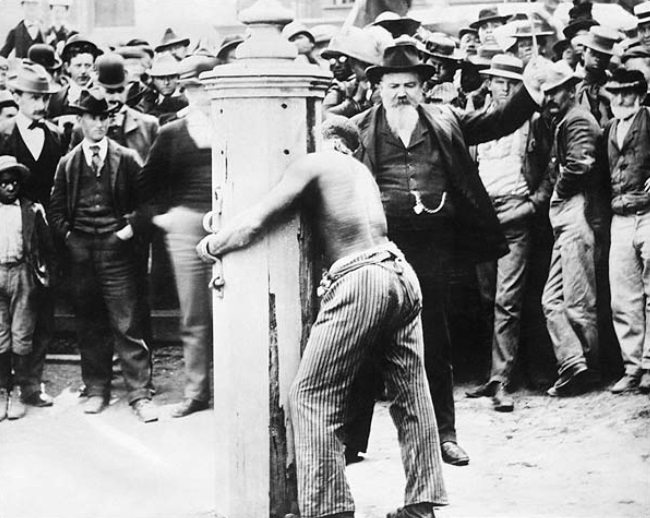The institution of slavery in America was marked by unimaginable cruelty, with enslavers using brutal punishments to enforce control, instill fear, and maintain submission among enslaved Black people. Below are ten documented methods of punishment that highlight the barbarity and heartbreak endured by enslaved individuals. These accounts draw from historical records, slave narratives, and scholarly sources.
1. Whipping and Flogging
Whipping was one of the most common forms of punishment, often administered with a whip, switch, or strap. Enslaved people, including pregnant women and children, were subjected to severe floggings for perceived offenses such as working too slowly or attempting to escape. The famous image of “Whipped Peter” (Gordon), with his back covered in a lattice of scars from repeated whippings, illustrates the brutality of this practice. Overseers sometimes poured salt, turpentine, or hot-pepper juice into wounds to intensify the pain, a practice known as “salting.”
2. Sexual Assault and Abuse
Enslaved women were frequently subjected to rape and sexual assault by white enslavers, their relatives, or overseers, with no legal recourse due to the lack of protection against such violence. These acts were often framed as punishment or a means of asserting dominance. Men and boys were also sexually abused, sometimes forced to impregnate female slaves to increase the enslaver’s “property.” The absence of legal protections meant that victims had no means to seek justice, and the resulting trauma often strained familial and community bonds.
3. Branding
Branding involved searing a letter or mark onto an enslaved person’s skin, often the face, to identify them as property or to punish runaways. In Louisiana, the “Code Noir” permitted branding as a penalty for attempting to escape from slavery. This permanent mark not only caused physical pain but also served as a humiliating reminder of enslavement, often preventing the individual from being assigned to less grueling tasks like housework.
4. Shackling and Chaining
Shackles and chains were used to restrain enslaved people, particularly during transport or as punishment for defiance. Made of heavy iron, these devices were applied to wrists, ankles, or necks, causing physical discomfort and restricting movement. On slave ships, enslaved Africans were packed tightly and shackled in inhumane conditions, and similar restraints were used on plantations to control and humiliate those who resisted. Some were forced to drag heavy objects, like a barrow, as an added degradation.
5. Mutilation and Amputation
Enslavers sometimes resorted to extreme physical mutilation, such as cutting off limbs, fingers, ears, or genitals, as punishment for offenses like theft or sexual misconduct, often based on false accusations. Castration was a particularly gruesome penalty for men, frequently performed without medical care, leading to severe injury or death. Such acts were designed to instill terror and deter resistance, leaving survivors with lifelong physical and psychological scars.
6. Family Separation
One of the most heartbreaking punishments was the deliberate separation of families through sale. Enslaved people were often sold to different owners, splitting parents from children and spouses from each other, with little hope of reunion. Elizabeth Keckley recounted the sale of a young boy, Little Joe, whose mother was whipped for grieving his loss, illustrating the emotional devastation caused by this practice. Family separation was a tool to break spirits and maintain control.
7. Torture Devices and Barbaric Contraptions
Enslavers employed sadistic devices for punishment, such as spiked collars, bellied collars, or hogsheads (barrels) with protruding nails. Moses Roper described an enslaver who forced slaves into nail-studded barrels and rolled them down hills for amusement. Spiked collars prevented rest, while belled collars humiliated runaways and made escape harder by signaling their movements. These devices combined physical pain with psychological torment.
8. Forced Breeding
To increase their workforce, enslavers engaged in “slave breeding,” forcing enslaved men and women into sexual relations to produce children who would inherit their mother’s enslaved status under the doctrine of partus sequitur ventrem. Women who bore many children were favored, while those who resisted faced punishment. This practice turned human reproduction into a profit-driven enterprise, stripping enslaved people of autonomy over their bodies and relationships.
9. Public Humiliation and Exposure
Enslaved people were subjected to public humiliation, such as being stripped naked during whippings or at slave auctions to display their bodies for potential buyers. Inadequate clothing was another form of humiliation, with some enslaved individuals, as noted by François-Jean de Chastellux, wearing only minimal garments that left them exposed. These acts reinforced their dehumanization and vulnerability, often exacerbating the risk of sexual violence.
10. Burning and Immolation
In extreme cases, enslaved people accused of serious crimes, such as murder or rebellion, were burned alive or lynched by immolation. Historical accounts document cases in Mississippi and Arkansas where enslaved men were burned at the stake for alleged crimes. These public spectacles were intended to terrorize enslaved communities and deter resistance, leaving a lasting legacy of fear and trauma.
The punishments inflicted on enslaved Black people in America were not only physically brutal but also designed to crush their spirit, dignity, and hope. These acts of violence—ranging from whippings and sexual assault to mutilation and family separation—reveal the profound inhumanity of slavery. By examining these historical realities, we honor the resilience of those who endured and resisted such atrocities, ensuring their stories are not forgotten.

